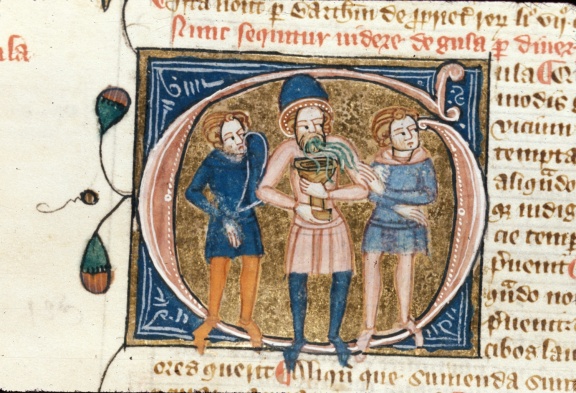By Jenny Weston
Medieval initials come in all shapes and sizes. They also come with different kinds of decoration. While some feature twisty vines, flowers, and other abstract designs, others present more detailed and distinctive figures and scenes.
Known as ‘historiated initials’, these portray figures or scenes that are clearly identifiable — they tell a story. In the initial ‘V’ above, we see the figure of Isaiah holding a scroll containing the opening words of the Old Testament book of Isaiah.
Some initials are more easily understood than others (at first glance). The following initial, for example, depicts Moses receiving the Ten Commandments from heaven. The identity of Moses is revealed via the context of the scene (God emerging from the clouds to deliver the tablets), as well as from the two little horns poking out of his head.
While this depiction of Moses with horns may seem unusual, to most medieval readers this would have been a familiar portrayal of the biblical figure. It is widely believed that Jerome made a simple translation error when creating the Latin Vulgate, which resulted in Moses being described as having ‘horns on his face’, as opposed to ‘light on his face’.
The figures presented in medieval historiated initials were not always biblical. Kings, queens, bishops, abbots, and even some popular authors also made appearances within the walls of the manuscript letter. In some (rather fun) cases, the author of a text is depicted in the initial, working on the very text in which he sits (like a mirror of a mirror…). In a copy of Peter Lombard’s Sententiae, for example, we see Lombard himself depicted in a large initial, happily working on the Sententiae. Such author portrayals could be compared to modern book-jackets that feature the author on the back cover!
Historiated initials might also contain a recognizable scene. In some cases, the artist used the initial to explain ideas or concepts discussed in the adjacent text. In a massive 14th-century encyclopedia known as the Omne Bonum (written by James Le Palmer), there are over 1100 folia and 650 illustrations that help the reader to conceptualize the terms presented in the text.
The following image, for instance, depicts the initial ‘G’ for Gula (or Gluttony). Here the artist does not simply showcase the individual eating or drinking too much, but instead visually warns of the adverse consequences of such actions.
Other examples appear to be designed to evoke an emotional response from the reader, perhaps spurring them prayer. One manuscript with a wide assortment of detailed (and somewhat gory) historiated initials is a collection of Saints’ Lives (Royal 20 D VI), currently held at the British Library. In this volume there are many colourful examples that depict the rather gruesome martyrdoms of various saints.
In addition to conjuring up emotional responses, these initials could also serve as a useful textual place-marker, helping the reader to find a specific part of the story without having to read through the text. If a reader wished to find a specific passage in William of Tyre’s Histoire d’Outremer (History of the Crusades), for example, he could simply search through the illustrative scenes at the opening of each new text. Here we see the Siege of Jerusalem (note the little man entering the hole in the wall):
- While historiated initials serve a variety of purposes (textual clarification, elaboration, and place-markers), they are also a testament to the artist’s talent. Manuscript initials provided a unique canvas for artists to show off their skills, which were often incredibly impressive and detailed. To end this brief foray into the world of the historiated initial, I would like to leave you with this wonderful example of Paul the Hermit reading alone in a shrub:









